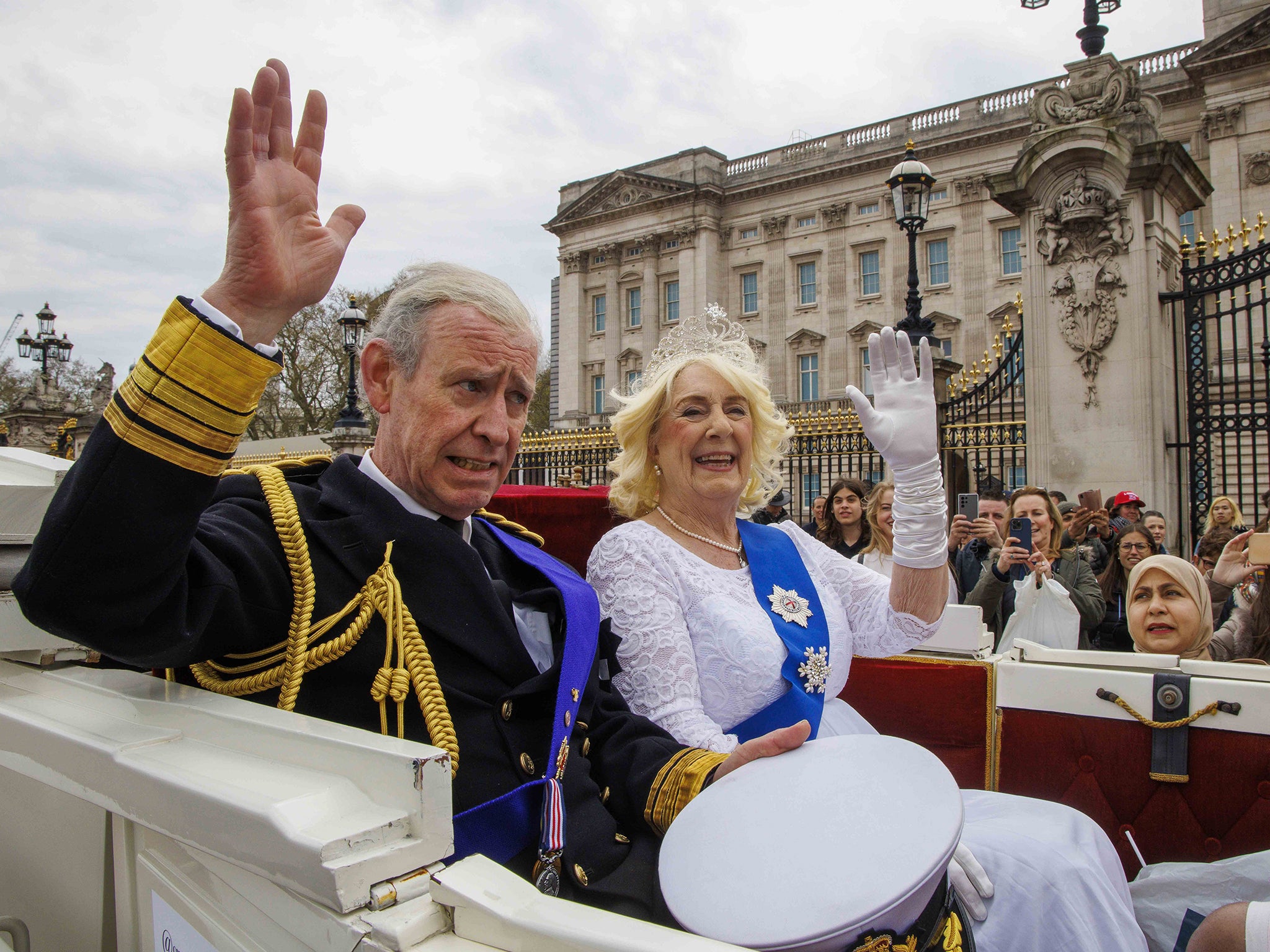The bonkers world of professional royal doppelgangers: ‘I played the Queen in a flea powder advert’
‘Camilla’ needs special looking-after, and ‘the Queen’ refuses to swear. As they prepare for the first coronation of their careers, the people who cash in on their royal resemblances speak to Katie Rosseinsky


Your support helps us to tell the story
From reproductive rights to climate change to Big Tech, The Independent is on the ground when the story is developing. Whether it's investigating the financials of Elon Musk's pro-Trump PAC or producing our latest documentary, 'The A Word', which shines a light on the American women fighting for reproductive rights, we know how important it is to parse out the facts from the messaging.
At such a critical moment in US history, we need reporters on the ground. Your donation allows us to keep sending journalists to speak to both sides of the story.
The Independent is trusted by Americans across the entire political spectrum. And unlike many other quality news outlets, we choose not to lock Americans out of our reporting and analysis with paywalls. We believe quality journalism should be available to everyone, paid for by those who can afford it.
Your support makes all the difference.When Heidi Agan was on the train last month, the conductor did a double take. “I was like, ‘Is my ticket wrong?’ Then he said, ‘You look just like Kate Middleton.’ And I said, ‘Thank you – that’s what I do.’”
A gracious response worthy of the royal herself. Perhaps it’s no wonder that Agan has got the Princessy small talk down to a fine art – she has been a professional Middleton lookalike for more than 10 years. At the peak of Kate’n’Wills mania, around the time of the royal couple’s 2011 wedding, Agan was waitressing at Frankie & Benny’s in Kettering. “Everybody was saying… could they be served by me? Could they have pictures?” she recalls.
Initially incredulous that she might be able to make a career out of the resemblance (“I didn’t believe [professional] lookalikes were real”), she eventually signed up with an agency the following year. “I got my first job four days later, so I didn’t really go back to the restaurant.” Since then, she’s worked solidly, appearing at corporate events (“sometimes we’re with Harry Potter or James Bond… or Elton John”), filming adverts for a Chinese milk brand, and travelling around the world.
As a Kate doppelganger, Agan is part of a “weird alternate family” of royal doubles, who are now gearing up for the first coronation of their careers. Their livelihoods have been supplemented or sustained by the world’s enduring fascination with the House of Windsor, and our collective desire to be adjacent to fame. “These representations of the real celebrity, they’re much more accessible – they’re out and about, they’re in public,” says artist Alison Jackson. Even so, it’s much harder than I anticipated to find lookalikes who are willing to chat about the work they do (some say they only accept paid media appearances; perhaps others are just channelling the royals’ “never complain, never explain” mantra).
Jackson is best known for her witty, hyperreal photographs imagining A-listers and royals in private, staged with lookalikes. Recent images, on show at her coronation-themed exhibition The Crown at London’s Grove Gallery imagine “William and Kate” reading Prince Harry’s autobiography Spare in bed and “Queen Camilla” sat on a throne surrounded by royal regalia, nursing a drink and a cigarette. She has become something of a star maker for the lookalike industry, placing call-outs on social media and now often doing castings over Zoom. “I use people off the street that look exactly like real [celebrities],” Jackson explains. “I style them, wig them, put them together… then they go into the lookalike industry and get an agent… because they understand that they can then make money out of the industry. And they do. I mean, they’re hired everywhere.”
Maybe royal lookalikes are so intriguing because the family has historically been “shrouded in mystery”, as Jackson puts it. The real Kate and Wills are unlikely to attend corporate meet and greets or pose with corgis; seeing lookalikes do those things feels a bit like falling into a very British, enjoyably camp uncanny valley. Sometimes, though, the reaction from the public can be a little too enthusiastic, with crowds taking liberties that they never would with the real deal. “They go absolutely berserk,” says Mary Reynolds, who retired as a Queen Elizabeth II lookalike after the monarch’s death last September. “I did a job once at Alexandra Palace… I was sitting on a throne and people were taking pictures. They were nearly pushing me off – it took about five security men to get me out when I finished.”
Reynolds’ decades-long career saw lookalike work go from a niche concern, providing a few ad hoc bookings, to a viable job. She was first told of her resemblance to the then-Princess Elizabeth when she was a 17-year-old on a trip to the Netherlands, but it wasn’t until she reached her late forties that she and her husband noticed people’s bemused responses in supermarkets and on public transport. After reading an article about a Prince Charles lookalike “who was doing so much work that he had packed up his regular job”, her husband took some photographs, which they sent off to an agent. Her first gig was “an advert for flea powder for dogs”, followed by “a pop video with a French pop group”.
You still have diehard Diana fans who will heckle, so sometimes we put a note with Camilla… just to say, be mindful that some people are still upset in some way
This was in the Seventies; lookalike work was still pretty unusual, and so agencies weren’t so keen to have multiples of the same royal on their books. When Jeannette Charles, the actress “who was the original Queen lookalike”, moved to the agency that Reynolds had been working with, “they didn’t want me any more because she was [more] well known”. It wasn’t until almost a decade later, in 1988, that Reynolds signed to another company. “The first thing I did was the Silver Nemesis, which was the 25th anniversary of Doctor Who.”
In the three-part serial, an asteroid crashes near Windsor Castle; producers reportedly tried to persuade Prince Edward to make a cameo, but when he declined, his loss was Reynolds’ gain. A few years later, she would switch things up, playing Princess Margaret in the film based on Andrew Morton’s bombshell biography Diana: Her True Story. She appeared in the background of a scene where the people’s princess, played by Serena Scott Thomas, “danced with Wayne Sleep at Covent Garden”.
Her most frequent co-stars, though, were corgis. “Once I nearly ended up in the Serpentine with five corgis, because we were standing near… and someone started throwing bread in for the ducks, which attracted the corgis. They’re so strong, I thought the lot of us were going to end up in the water.” You can only imagine the baffled response from tourists and dog walkers.
When she learned of the Queen’s death last autumn, Reynolds knew that she would stop working “out of respect” at the age of 89. It’s common for lookalikes to “feel a personal connection” to the person they’re embodying, explains Helen Victoria, marketing manager at events specialists Scarlett Entertainment. Some are wary of doing anything that might appear to mock “their” royal, she adds, recalling how one prospective client wanted a Queen Elizabeth II act to swear. “She wouldn’t do it… it would seem disrespectful.”
Reynolds says she was a lifelong fan of the monarch: she was on the Mall for her wedding to Prince Philip in 1947, and later camped out for the 1953 coronation (“we had to sleep in the road… we only had newspapers to protect us, we didn’t have sleeping bags and tents”).
Her retirement is just one example of how the work of a lookalike is shaped by the life of the royal they resemble. Agan no longer gets booked on jobs with “Harrys” and “Meghans” she once worked closely with, thanks to their much-publicised royal rift. “Everybody says to me, ‘Oh, do you hate the Meghan and Harry lookalikes?’ No, they’re really lovely. We miss working with them… The whole situation in real life is really sad, but it sort of carries over [into the lookalike world]. We still speak, obviously, because we’re friends, but it’s weird how [work] mirrors what’s happening in real life.”
And just as the impending coronation has put the spotlight on King Charles and his Queen, Camilla, so interest in their (formerly underlooked) lookalikes has soared. Scarlett Entertainment’s resident Camilla, former headteacher Jane Mosse, has suddenly become “super busy” in a way she didn’t anticipate, Victoria says. If “Camilla” is booked for a public appearance, rather than a private event, she adds, the company warns clients in advance to “look after” her. “You still have diehard Diana fans who will heckle, so sometimes we put a note with Camilla… just to say, be mindful that some people are still upset in some way,” she explains. “Sometimes you’ll get people saying things, and obviously we don’t want to upset our act, because they’re just there doing a performance job.”

For better or worse, it seems, a lookalike must ride the wave of the public’s attitude towards “their” royal, and that can differ from gig to gig. Jackson suggests that the adulation might be more damaging than the odd heckle. “Some have an identity crisis because suddenly, you have all these people worshipping you, as [they] worship celebrities,” she says. “It’s quite an extraordinary thing.”
The disjunction between ordinary life and, say, flying first class to Australia to shoot an advert, or being jetted off to Hong Kong for a whirlwind trip, can be a little jarring, Agan concedes. “You’ve done this amazing thing in this amazing place, and then you come home and everything’s normal again,” she says (so normal that when we speak over the phone, she apologises if she sounds out of breath – she’s been sweeping up outside). “We get these snapshots of what it would be like to be famous, but then you come back to reality very quickly. I wouldn’t want to be in her situation all the time.”
The first week of May will give her plenty of those “snapshots” – she’s block-booked for coronation festivities, a nice bounce back after the fallow period of the pandemic, which hit the events industry hard. “It’s also amazing to sort of be a part of history,” she says, “in my own little way.”
‘The Crown’ exhibition is at the Grove Gallery until 27 May



Join our commenting forum
Join thought-provoking conversations, follow other Independent readers and see their replies
Comments